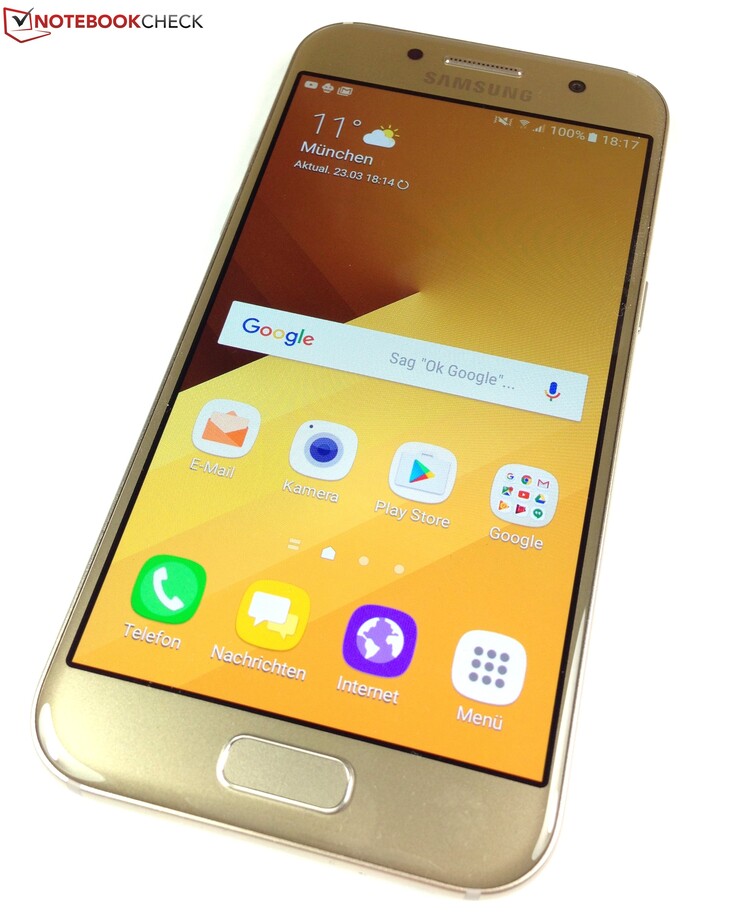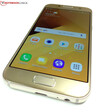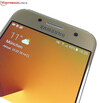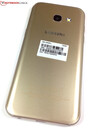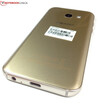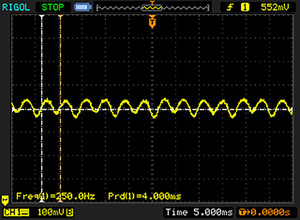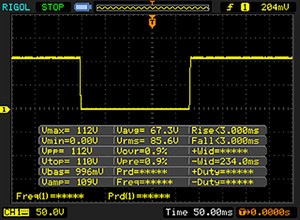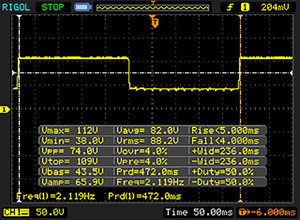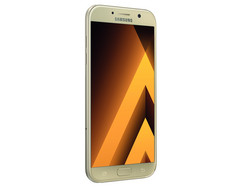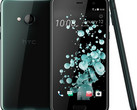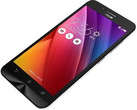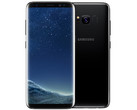Recensione Breve dello Smartphone Samsung Galaxy A3 (2017)
I nostri Top 10
» Top 10 Portatili Multimedia
» Top 10 Portatili Gaming
» Top 10 Portatili Gaming Leggeri
» Top 10 Portatili da Ufficio e Business economici
» Top 10 Portatili Premium da Ufficio/Business
» Top 10 Portatili sotto i 300 Euro
» Top 10 Portatili sotto i 500 Euro
» Top 10 dei Portatili Workstation
» Top 10 Subnotebooks
» Top 10 Ultrabooks
» Top 10 Convertibili
» Top 10 Tablets
» Top 10 Tablets Windows
» Top 10 Smartphones
Size comparison
| Networking | |
| iperf3 transmit AX12 | |
| Lenovo ZUK Z2 | |
| BQ Aquaris X5 Plus | |
| Samsung Galaxy A3 2017 | |
| HTC One A9s | |
| Wiko U Feel Prime | |
| Huawei Nova | |
| iperf3 receive AX12 | |
| BQ Aquaris X5 Plus | |
| Samsung Galaxy A3 2017 | |
| Lenovo ZUK Z2 | |
| HTC One A9s | |
| Wiko U Feel Prime | |
| Huawei Nova | |
| |||||||||||||||||||||||||
Distribuzione della luminosità: 94 %
Al centro con la batteria: 574 cd/m²
Contrasto: ∞:1 (Nero: 0 cd/m²)
ΔE ColorChecker Calman: 2.4 | ∀{0.5-29.43 Ø4.78}
ΔE Greyscale Calman: 1.9 | ∀{0.09-98 Ø5}
Gamma: 2.09
CCT: 6502 K
| Samsung Galaxy A3 2017 Super AMOLED, 1280x720, 4.7" | BQ Aquaris X5 Plus IPS, 1920x1080, 5" | Huawei Nova IPS, 1920x1080, 5" | HTC One A9s IPS, 1280x720, 5" | Lenovo ZUK Z2 IPS, 1920x1080, 5" | Wiko U Feel Prime IPS, 1920x1080, 5" | Samsung Galaxy A3 2016 Super AMOLED, 1280x720, 4.7" | |
|---|---|---|---|---|---|---|---|
| Screen | -16% | -47% | -53% | -55% | -51% | 4% | |
| Brightness middle (cd/m²) | 574 | 640 11% | 493 -14% | 348 -39% | 512 -11% | 411 -28% | 386 -33% |
| Brightness (cd/m²) | 576 | 609 6% | 485 -16% | 320 -44% | 502 -13% | 386 -33% | 394 -32% |
| Brightness Distribution (%) | 94 | 85 -10% | 94 0% | 85 -10% | 84 -11% | 86 -9% | 88 -6% |
| Black Level * (cd/m²) | 0.93 | 0.44 | 0.23 | 0.58 | 0.36 | ||
| Colorchecker dE 2000 * | 2.4 | 2.8 -17% | 4.2 -75% | 3.5 -46% | 3.8 -58% | 4.3 -79% | 1.11 54% |
| Colorchecker dE 2000 max. * | 3.8 | 5.7 -50% | 6.6 -74% | 6.4 -68% | 11.2 -195% | 7.9 -108% | 3.35 12% |
| Greyscale dE 2000 * | 1.9 | 2.6 -37% | 3.8 -100% | 4 -111% | 2.7 -42% | 2.8 -47% | 1.34 29% |
| Gamma | 2.09 105% | 2.35 94% | 2.39 92% | 2.3 96% | 2.09 105% | 2.53 87% | 2.12 104% |
| CCT | 6502 100% | 6477 100% | 7438 87% | 6527 100% | 6076 107% | 6589 99% | 6441 101% |
| Contrast (:1) | 688 | 1120 | 1513 | 883 | 1142 |
* ... Meglio usare valori piccoli
Sfarfallio dello schermo / PWM (Pulse-Width Modulation)
| flickering dello schermo / PWM rilevato | 250 Hz | ||
Il display sfarfalla a 250 Hz (Probabilmente a causa dell'uso di PWM) . La frequenza di 250 Hz è relativamente bassa, quindi gli utenti sensibili potrebbero notare il flickering ed accusare stanchezza agli occhi a questo livello di luminosità e a livelli inferiori. In confronto: 53 % di tutti i dispositivi testati non utilizza PWM per ridurre la luminosita' del display. Se è rilevato PWM, una media di 8108 (minimo: 5 - massimo: 343500) Hz è stata rilevata. | |||
Tempi di risposta del Display
| ↔ Tempi di risposta dal Nero al Bianco | ||
|---|---|---|
| 6 ms ... aumenta ↗ e diminuisce ↘ combinato | ↗ 3 ms Incremento | |
| ↘ 3 ms Calo | ||
| Lo schermo ha mostrato valori di risposta molto veloci nei nostri tests ed è molto adatto per i gaming veloce. In confronto, tutti i dispositivi di test variano da 0.1 (minimo) a 240 (massimo) ms. » 17 % di tutti i dispositivi è migliore. Questo significa che i tempi di risposta rilevati sono migliori rispettto alla media di tutti i dispositivi testati (20.2 ms). | ||
| ↔ Tempo di risposta dal 50% Grigio all'80% Grigio | ||
| 9 ms ... aumenta ↗ e diminuisce ↘ combinato | ↗ 5 ms Incremento | |
| ↘ 4 ms Calo | ||
| Lo schermo mostra veloci tempi di risposta durante i nostri tests e dovrebbe esere adatto al gaming In confronto, tutti i dispositivi di test variano da 0.165 (minimo) a 636 (massimo) ms. » 21 % di tutti i dispositivi è migliore. Questo significa che i tempi di risposta rilevati sono migliori rispettto alla media di tutti i dispositivi testati (31.6 ms). | ||
| AnTuTu v6 - Total Score (ordina per valore) | |
| Samsung Galaxy A3 2017 | |
| BQ Aquaris X5 Plus | |
| Huawei Nova | |
| HTC One A9s | |
| Lenovo ZUK Z2 | |
| Wiko U Feel Prime | |
| Samsung Galaxy A3 2016 | |
| Geekbench 4.0 | |
| 64 Bit Single-Core Score (ordina per valore) | |
| Samsung Galaxy A3 2017 | |
| BQ Aquaris X5 Plus | |
| Huawei Nova | |
| HTC One A9s | |
| Wiko U Feel Prime | |
| 64 Bit Multi-Core Score (ordina per valore) | |
| Samsung Galaxy A3 2017 | |
| BQ Aquaris X5 Plus | |
| Huawei Nova | |
| HTC One A9s | |
| Wiko U Feel Prime | |
| GFXBench (DX / GLBenchmark) 2.7 | |
| T-Rex Onscreen (ordina per valore) | |
| Samsung Galaxy A3 2017 | |
| BQ Aquaris X5 Plus | |
| Huawei Nova | |
| HTC One A9s | |
| Lenovo ZUK Z2 | |
| Wiko U Feel Prime | |
| Samsung Galaxy A3 2016 | |
| 1920x1080 T-Rex Offscreen (ordina per valore) | |
| Samsung Galaxy A3 2017 | |
| BQ Aquaris X5 Plus | |
| Huawei Nova | |
| HTC One A9s | |
| Lenovo ZUK Z2 | |
| Wiko U Feel Prime | |
| Samsung Galaxy A3 2016 | |
| GFXBench 3.0 | |
| on screen Manhattan Onscreen OGL (ordina per valore) | |
| Samsung Galaxy A3 2017 | |
| BQ Aquaris X5 Plus | |
| Huawei Nova | |
| HTC One A9s | |
| Lenovo ZUK Z2 | |
| Wiko U Feel Prime | |
| Samsung Galaxy A3 2016 | |
| 1920x1080 1080p Manhattan Offscreen (ordina per valore) | |
| Samsung Galaxy A3 2017 | |
| BQ Aquaris X5 Plus | |
| Huawei Nova | |
| HTC One A9s | |
| Lenovo ZUK Z2 | |
| Wiko U Feel Prime | |
| Samsung Galaxy A3 2016 | |
| GFXBench 3.1 | |
| on screen Manhattan ES 3.1 Onscreen (ordina per valore) | |
| Samsung Galaxy A3 2017 | |
| BQ Aquaris X5 Plus | |
| Huawei Nova | |
| HTC One A9s | |
| Lenovo ZUK Z2 | |
| Wiko U Feel Prime | |
| 1920x1080 Manhattan ES 3.1 Offscreen (ordina per valore) | |
| Samsung Galaxy A3 2017 | |
| BQ Aquaris X5 Plus | |
| Huawei Nova | |
| HTC One A9s | |
| Lenovo ZUK Z2 | |
| Wiko U Feel Prime | |
| PCMark for Android - Work performance score (ordina per valore) | |
| Samsung Galaxy A3 2017 | |
| BQ Aquaris X5 Plus | |
| Huawei Nova | |
| HTC One A9s | |
| Lenovo ZUK Z2 | |
| Wiko U Feel Prime | |
| Samsung Galaxy A3 2016 | |
| Octane V2 - Total Score (ordina per valore) | |
| Samsung Galaxy A3 2017 | |
| BQ Aquaris X5 Plus | |
| Huawei Nova | |
| HTC One A9s | |
| Lenovo ZUK Z2 | |
| Wiko U Feel Prime | |
| Samsung Galaxy A3 2016 | |
| Mozilla Kraken 1.1 - Total (ordina per valore) | |
| Samsung Galaxy A3 2017 | |
| BQ Aquaris X5 Plus | |
| Huawei Nova | |
| HTC One A9s | |
| Lenovo ZUK Z2 | |
| Wiko U Feel Prime | |
| Samsung Galaxy A3 2016 | |
| WebXPRT 2015 - Overall (ordina per valore) | |
| Samsung Galaxy A3 2017 | |
| Huawei Nova | |
| HTC One A9s | |
| Samsung Galaxy A3 2016 | |
| JetStream 1.1 - Total Score (ordina per valore) | |
| Samsung Galaxy A3 2017 | |
| BQ Aquaris X5 Plus | |
| Huawei Nova | |
| HTC One A9s | |
| Lenovo ZUK Z2 | |
| Wiko U Feel Prime | |
| Samsung Galaxy A3 2016 | |
* ... Meglio usare valori piccoli
| Samsung Galaxy A3 2017 Mali-T830 MP1, 7870 Octa, 16 GB eMMC Flash | BQ Aquaris X5 Plus Adreno 510, 652 MSM8976, 16 GB eMMC Flash | Huawei Nova Adreno 506, 625, 32 GB eMMC Flash | HTC One A9s Mali-T860 MP2, Helio P10 MT6755, 32 GB eMMC Flash | Lenovo ZUK Z2 Adreno 530, 820 MSM8996, 64 GB eMMC Flash | Wiko U Feel Prime Adreno 505, 430, 32 GB eMMC Flash | Samsung Galaxy A3 2016 Mali-T720 MP2, 7578, 16 GB eMMC Flash | |
|---|---|---|---|---|---|---|---|
| AndroBench 3-5 | 20% | 87% | 35% | -6% | 51% | -13% | |
| Sequential Read 256KB (MB/s) | 199.7 | 228.4 14% | 248.3 24% | 210.2 5% | 239.4 20% | 270.9 36% | 168.8 -15% |
| Sequential Write 256KB (MB/s) | 45.96 | 47.03 2% | 75 63% | 68.6 49% | 46.52 1% | 137.3 199% | 27.27 -41% |
| Random Read 4KB (MB/s) | 22.32 | 36.85 65% | 38.19 71% | 21.3 -5% | 21.27 -5% | 55 146% | 21.92 -2% |
| Random Write 4KB (MB/s) | 9.62 | 12.44 29% | 44.63 364% | 34.6 260% | 5.64 -41% | 9.4 -2% | 10.27 7% |
| Sequential Read 256KB SDCard (MB/s) | 75.5 | 73.2 -3% | 79.5 5% | 39.6 -48% | 41.98 -44% | ||
| Sequential Write 256KB SDCard (MB/s) | 50.1 | 54.9 10% | 47.69 -5% | 25.6 -49% | 35.21 -30% |
| Asphalt 8: Airborne | |||
| Settaggi | Valore | ||
| high | 23 fps | ||
| very low | 29 fps | ||
| Dead Trigger 2 | |||
| Settaggi | Valore | ||
| high | 52 fps | ||
(+) La temperatura massima sul lato superiore è di 31.8 °C / 89 F, rispetto alla media di 35.2 °C / 95 F, che varia da 21.9 a 247 °C per questa classe Smartphone.
(+) Il lato inferiore si riscalda fino ad un massimo di 32 °C / 90 F, rispetto alla media di 34 °C / 93 F
(+) In idle, la temperatura media del lato superiore è di 27.3 °C / 81 F, rispetto alla media deld ispositivo di 32.9 °C / 91 F.
Samsung Galaxy A3 2017 analisi audio
(+) | gli altoparlanti sono relativamente potenti (82.6 dB)
Bassi 100 - 315 Hz
(-) | quasi nessun basso - in media 19.2% inferiori alla media
(±) | la linearità dei bassi è media (9.7% delta rispetto alla precedente frequenza)
Medi 400 - 2000 Hz
(±) | medi elevati - circa 8.7% superiore alla media
(±) | linearità dei medi adeguata (7.4% delta rispetto alla precedente frequenza)
Alti 2 - 16 kHz
(±) | alti elevati - circa 5.6% superiori alla media
(+) | alti lineari (6.9% delta rispetto alla precedente frequenza)
Nel complesso 100 - 16.000 Hz
(±) | la linearità complessiva del suono è media (26.1% di differenza rispetto alla media
Rispetto alla stessa classe
» 66% di tutti i dispositivi testati in questa classe è stato migliore, 6% simile, 28% peggiore
» Il migliore ha avuto un delta di 11%, medio di 35%, peggiore di 134%
Rispetto a tutti i dispositivi testati
» 80% di tutti i dispositivi testati in questa classe è stato migliore, 4% similare, 16% peggiore
» Il migliore ha avuto un delta di 4%, medio di 24%, peggiore di 134%
Samsung Galaxy A3 2016 analisi audio
(+) | gli altoparlanti sono relativamente potenti (84.4 dB)
Bassi 100 - 315 Hz
(-) | quasi nessun basso - in media 32.6% inferiori alla media
(±) | la linearità dei bassi è media (11.5% delta rispetto alla precedente frequenza)
Medi 400 - 2000 Hz
(+) | medi bilanciati - solo only 3.2% rispetto alla media
(+) | medi lineari (6.5% delta rispetto alla precedente frequenza)
Alti 2 - 16 kHz
(+) | Alti bilanciati - appena 4% dalla media
(+) | alti lineari (5.5% delta rispetto alla precedente frequenza)
Nel complesso 100 - 16.000 Hz
(±) | la linearità complessiva del suono è media (22.8% di differenza rispetto alla media
Rispetto alla stessa classe
» 50% di tutti i dispositivi testati in questa classe è stato migliore, 6% simile, 44% peggiore
» Il migliore ha avuto un delta di 11%, medio di 35%, peggiore di 134%
Rispetto a tutti i dispositivi testati
» 67% di tutti i dispositivi testati in questa classe è stato migliore, 6% similare, 28% peggiore
» Il migliore ha avuto un delta di 4%, medio di 24%, peggiore di 134%
HTC One A9s analisi audio
(+) | gli altoparlanti sono relativamente potenti (82.6 dB)
Bassi 100 - 315 Hz
(-) | quasi nessun basso - in media 18.2% inferiori alla media
(±) | la linearità dei bassi è media (13.5% delta rispetto alla precedente frequenza)
Medi 400 - 2000 Hz
(±) | medi elevati - circa 5.4% superiore alla media
(+) | medi lineari (5.4% delta rispetto alla precedente frequenza)
Alti 2 - 16 kHz
(±) | alti elevati - circa 11.7% superiori alla media
(±) | la linearità degli alti è media (8.3% delta rispetto alla precedente frequenza)
Nel complesso 100 - 16.000 Hz
(±) | la linearità complessiva del suono è media (28.6% di differenza rispetto alla media
Rispetto alla stessa classe
» 74% di tutti i dispositivi testati in questa classe è stato migliore, 4% simile, 21% peggiore
» Il migliore ha avuto un delta di 11%, medio di 35%, peggiore di 134%
Rispetto a tutti i dispositivi testati
» 86% di tutti i dispositivi testati in questa classe è stato migliore, 3% similare, 12% peggiore
» Il migliore ha avuto un delta di 4%, medio di 24%, peggiore di 134%
| Off / Standby | |
| Idle | |
| Sotto carico |
|
Leggenda:
min: | |
| Samsung Galaxy A3 2017 2350 mAh | BQ Aquaris X5 Plus 3200 mAh | Huawei Nova 3020 mAh | HTC One A9s 2300 mAh | Lenovo ZUK Z2 3500 mAh | Wiko U Feel Prime 3000 mAh | Samsung Galaxy A3 2016 2300 mAh | |
|---|---|---|---|---|---|---|---|
| Power Consumption | -137% | -111% | -185% | -193% | -94% | -82% | |
| Idle Minimum * (Watt) | 0.37 | 0.87 -135% | 0.61 -65% | 1.29 -249% | 1.31 -254% | 0.66 -78% | 0.96 -159% |
| Idle Average * (Watt) | 0.78 | 1.33 -71% | 1.83 -135% | 2.28 -192% | 2.03 -160% | 1.66 -113% | 1.39 -78% |
| Idle Maximum * (Watt) | 0.84 | 1.35 -61% | 1.86 -121% | 2.52 -200% | 2.08 -148% | 1.76 -110% | 1.45 -73% |
| Load Average * (Watt) | 1.52 | 5.44 -258% | 3.71 -144% | 4.06 -167% | 5.45 -259% | 2.85 -88% | 2.65 -74% |
| Load Maximum * (Watt) | 2.75 | 7.11 -159% | 5.19 -89% | 5.91 -115% | 6.75 -145% | 5.01 -82% | 3.51 -28% |
* ... Meglio usare valori piccoli
| Samsung Galaxy A3 2017 2350 mAh | BQ Aquaris X5 Plus 3200 mAh | Huawei Nova 3020 mAh | HTC One A9s 2300 mAh | Lenovo ZUK Z2 3500 mAh | Wiko U Feel Prime 3000 mAh | Samsung Galaxy A3 2016 2300 mAh | |
|---|---|---|---|---|---|---|---|
| Autonomia della batteria | -24% | -17% | -41% | -18% | -35% | -20% | |
| Reader / Idle (h) | 47.7 | 31.2 -35% | 25.7 -46% | 20.9 -56% | 33 -31% | ||
| H.264 (h) | 16.5 | 12 -27% | 9.8 -41% | 14.4 -13% | |||
| WiFi v1.3 (h) | 11.1 | 8.4 -24% | 14.6 32% | 8.6 -23% | 9.1 -18% | 9.6 -14% | 10.5 -5% |
| Load (h) | 8.9 | 5.5 -38% | 4.1 -54% | 6.3 -29% |
Pro
Contro
C'è poca necessità di effettuare l'upgrade per chi già possiede il Galaxy A3 dall'anno scorso (2016). Con la sua simile qualità di costruzione, il modello di quest'anno ha però alcuni vantaggi.
Prima di tutto il Galaxy A3 (2017) è ora IP68 anti polvere e impermeabile. Inoltre, è dotato di una porta USB di tipo C, non ha più una fotocamera che sporge dalla parte posteriore, sembra significativamente più resistente grazie alla mancanza della struttura argentata, ed ha un più recente sistema operativo Android 6.0.1.
L'aggiornamento del processore per il più veloce Exynos 7870 ha avuto l'effetto atteso sulle perfomance complessive. I miglioramenti della durata della batteria sono più importanti: grazie alla sua incredibile efficienza energetica il Galaxy A3 (2017) è un dispositivo estremamente duraturo. Entrambe le fotocamere sono state migliorate, e le ultime e si comportano molto meglio in condizioni di scarsa illuminazione. La fotocamera frontale è stata aggiornata da 5 a 8 megapixel.
Il Galaxy A3 (2017) è ben lontano dal reinventare la ruota; invece, ma i suoi miglioramenti sono stati delicati ed efficaci.
Nonostante il suo formato da 4,7 pollici gestibile e abbastanza comodo, il retro liscio può causare fastidio ad alcuni utenti. L'unica cosa che si può veramente fare è provare da soli se il telefono appare instabile. Non siamo per il coperchio posteriore in vetro. Eppure non v'è alcun modo per addolcire le carenze del telefono: manca MHL, nessun supporto per dual SIM-card, e nessuna stabilizzazione ottica dell'immagine. Alcuni utenti potrebbero anche notare il PWM-flickering a livelli di luminosità al di sotto del 92%. Nonostante queste limitazioni, il Galaxy A3 (2017) rimane uno smartphone mid-range molto solido e rispettabile con pochi motivi di reclami.
Nota: si tratta di una recensione breve, con alcune sezioni non tradotte, per la versione integrale in inglese guardate qui.
There is little to no need for an upgrade for those who already own last year's Galaxy A3 (2016). With its similar build quality, this year's model does have a few advantages, though.
First of all the Galaxy A3 (2017) is now IP68 dust- and waterproof. In addition, it features a USB Type-C port, does not have its camera protruding from the back anymore, seems significantly sturdier thanks to the lack of aforementioned silver frame, and it's running a more recent Android 6.0.1 operating system.
Upgrading the processor to the faster Exynos 7870 did have the expected effect on overall performance. The battery life improvements are more important: due to its incredible power efficiency the Galaxy A3 (2017) is an extremely durable beast. Both cameras have been improved as well, and the latest reiteration fares much better under low-light conditions. The front-facing camera has been updated from 5 to 8 megapixels.
The Galaxy A3 (2017) is a far cry from reinventing the wheel; instead, its iterative improvements have been gentle and effective.
Despite its manageable and quite handy 4.7-inch form factor, the smooth back side may cause quite a stir with some users. The only thing you can really do is try for yourself whether or not the phone feels slippery. We for one did not mind the glassy back cover. Yet there is no way to sugarcoat the phone’s shortcomings: no MHL, no dual SIM-card support, and no optical image stabilization. Some users might also notice PWM-flickering at brightness levels below 92%. In spite of these limitations, the Galaxy A3 (2017) remains a very solid and respectable mid-range smartphone with little cause for complaint.
Samsung Galaxy A3 2017
- 09/03/2022 v7 (old)
Manuel Masiero




